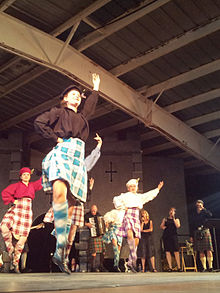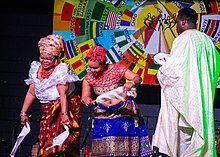Folklorama
| Folklorama | |
|---|---|
 Folklorama 2012 India Pavilion | |
| Frequency | Annually |
| Location(s) | Winnipeg, Manitoba, Canada |
| Years active | 55 |
| Inaugurated | 1970[1] |
| Next event | August 3–16, 2025 |
| Participants | 8,000 volunteers giving 300,000 hours (2022) |
| Attendance | 168,516 (2022) |
| Website | www |
Folklorama is an event that runs for two weeks each August in Winnipeg, Manitoba, Canada. Visitors to the festival are invited to sample cuisine and celebrate the cultural and ethnic heritage of people from dozens of cultures who have made Winnipeg their home.[2] Folklorama is the world's largest and longest-running multicultural festival.[2][3]
Each culture has an assigned venue, known as a pavilion. Typically there are over 40 pavilions presented throughout the city, with half operating in week one and half in week two of the festival.[4] Each pavilion presents a show featuring the song and dance of their culture, along with trademark ethnic cuisine and a cultural display. Some pavilions also incorporate additional services such as henna tattoo application, steel pan drum workshops, and some have late night parties. Most pavilions provide imported cultural beverage.
Folklorama provides exposure to cultural groups and brings in thousands of tourists each year, adding to the city's economy. It is the largest and longest-running festival of its kind in the world.[3] The Folk Arts Council of Winnipeg is the organizing body of Folklorama.
History


Folklorama was first held in August 1970, as a Centennial Folk Festival sponsored jointly by the City of Winnipeg and the Folk Arts Council of Manitoba.[5] It was originally intended to be a one-time occurrence in celebration of Manitoba's centennial. It was deemed such a success that it became an annual event. The first festival was only a week long, featuring 21 different cultures. The Indian, Greek, Portuguese, Ukraine, and the Africa/Caribbean Pavilions were one of the festival's original six pavilions;[6] it drew approximately 50,000 people across 75,000 separate pavilion visits.[7][1] The festival adopted its current two-week format in 1988, with half of the pavilions open in each week.
The Folklorama logo was designed by Andy Stout who won the provincial logo contest in 1980. The 4 figures in the logo represent people from the four corners of the globe, who are intertwined, with arms raised in celebration. The festival's mascot, the Folklorama Llama, was created in 1986.[1]
Until 1989, pavilions would have a mayor and a queen.[8] The queen would be in the running for the Miss Folklorama pageant at the closing ceremony of the Festival. The Miss Folklorama pageant was not a beauty pageant but a "contest of ethnic preservation and presentation", as the pavilion queens were scored based on 40% knowledge of culture and country, 40% on participation and 20% on poise and personality.[9] Since 1990, pavilions now feature two adult ambassadors and two youth ambassadors, neither of whom must be of a specific gender.[6]
The 50th edition of the Folklorama festival was in 2019. There were 22 pavilions in the first week including: African, Argentina "Tango", Budapest-Hungaria, Caribbean, Celtic Ireland, Chile, Egyptian, El Salvador, Ethiopian, First Nations, German, Greek, India, Israel "Shalom Square", Korean, España-Spain, Portugal, Scandinavian, Serbian/Beograd, Slovenija, Ukraine "Spirt of the Ukraine", and the United Kingdom. There were 23 pavilions in the second week, including: Africa/Caribbean, Brazilian, Canadien-Français, Chilean, Chinese, Croatian "Zagreb", Hungary-Pannonia, Irish, Italian, Japanese, Métis, Mexican, Scotland, Philippines "Pearl of the Orient", Portuguese "Casa do Minho", Polish, Punjab, Romanian, Russian, Serbian "Kolo", South Sudanese, Tamil, and Ukraine-Kyiv.[10]
Folklorama was cancelled in 2020 and 2021 due to the COVID-19 pandemic, but resumed in 2022 with 24 pavilions and a 14% increase in attendance over 2019.[11] In 2023, the number of pavilions offered increased to 40.[12]
Program areas
Throughout the year, Folklorama is sustained by its Ethno-Cultural Arts Division and programs: Folklorama at Home, Folklorama at School, Folklorama at Work, and Folklorama at Play.

Statistics
- On average, Folklorama receives approximately 400,000 pavilion visits each year. The 2022 Festival received 168,516 pavilion visits to 24 pavilions.[11] The majority of those who attend the Festival visit more than one pavilion.
- About 21% of pavilion visitors come from outside of Winnipeg.[13]
- Typically, more than 3,000 entertainers perform at more than 1,500 shows throughout the two-week Festival.[13]
- On average, 600,000 meals are served and 1,000,000 beverages are poured before the conclusion of the Festival.[13]
- Approximately 20,000 volunteers participate to make Folklorama possible.[10]
- Folklorama has an economic impact of about $14.7 million on the Manitoba economy.[13]
References
- ^ a b c "History". Folklorama. http://www.folklorama.ca/index.php?option=com_content&view=article&id=58&Itemid=56 Archived July 30, 2009, at the Wayback Machine. Retrieved July 14, 2009.
- ^ a b "Folklorama kicks off this weekend". Global News. August 3, 2012. Retrieved August 6, 2012.
- ^ a b "International Council of Organizations of Folklore Festivals and Folk Arts: Folklorama". Retrieved February 9, 2022.
- ^ "What to Expect". Archived from the original on August 9, 2012. Retrieved August 1, 2012.
- ^ "Folklorama '70 Next Week In Winnipeg". Arborg Lake Centre News. July 31, 1970. Retrieved July 27, 2020.
- ^ a b "FOLKLORAMA". Afro-Caribbean Association of Manitoba. Archived from the original on September 19, 2012. Retrieved August 13, 2012.
- ^ "Juba Wants Folkfest Encore In 1971". Winnipeg Free Press. October 16, 1970. Retrieved July 27, 2020.
- ^ Maloney, Carreen (August 22, 1989). "Folklorama queen laments end of tradition". Winnipeg Free Press. Retrieved July 27, 2020.
- ^ Whysall, Steve (August 15, 1978). "Folklorama queens are more than just beautiful girls". Winnipeg Free Press. Retrieved July 28, 2020.
- ^ a b "Folkorama Annual Report, 2019" (PDF). Retrieved February 9, 2022.
- ^ a b "Folklorama Annual Report 2022" (PDF). Folklorama. Retrieved January 8, 2024.
- ^ "Folklorama – Find a Pavilion". folklorama.ca. Retrieved January 8, 2024.
- ^ a b c d "FAQs". Folklorama. "FAQs". Archived from the original on August 11, 2010. Retrieved November 11, 2009.. Accessed August 1, 2012.
